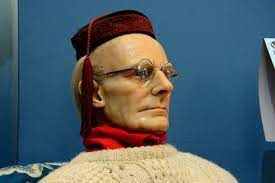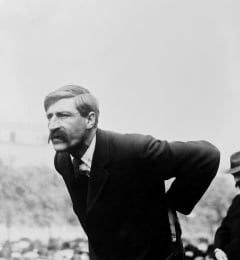An raibh a fhios agat? Did you know?
Seán O’Casey
The life of Seán O’Casey has been described and might indeed be determined as an interesting account of the travails of a writer seeking recognition like any of his class. However, one might be forgiven for accepting that class was indeed the determining factor that brought him acceptance by some and rejection by others. The Dublin into which O’Casey was born was still convulsing from deprivation of the body but instinctively galvanising itself as an instrument of idealism to forge a better future. In a divided city, capital of a divided country the struggle for the rights of workers and their families loomed large in his orbit. O’Casey, whose fight was for labour rights for workers, apparently was at odds with some of the leading protagonists in Ireland’s fight for independence and what he saw as republican rhetoric instead of the needs of the poor and destitute. This brief overview cannot do him justice and begs your indulgence.
Introduction
O’Casey was born on March 30th 1880 into a Dublin of ever increasing marginalisation in Dorset Street. He has been described as a Socialist, a Trade Unionist but might best be described as someone who wore his ‘heart on his sleeve’. He was the last of thirteen children born to the Casey’s, eight of whom died in infancy, a number of them from the croup. The fortunes of the family were alas on the decline and this factor along with the loss of so many of his siblings perhaps had the most profound effect on shaping the boy. The squalor that was the reality of tenement Dublin also had a huge impact on his health being affected as he was by a deterioration in his eyesight owing to ulcerated corneas, as Kraus (1997) reminds us. It is worth recounting perhaps how some observers viewed the situation in the tenements as being worse or on a par with conditions in the trenches during World War One. The poor were condemned to live in appalling conditions with little no sanitation.
 It was from this cellar of conceit that the young O’Casey would have to rise. His journey was not made any easier by the death of his father when he was a mere six years of age. He eventually obtained permanent employment with the Great Northern Railway (GNR) in 1903 as a labourer. He was subsequently dismissed by the GNR for his trade union activity in 1911. Hunger was no stranger to him as he often joined the ranks of the unemployed. He would eventually find solace by writing articles in the Irish Worker while active in the Trade Union movement. Lowery (1983) points to his criticism of the ‘liberation movement’ in the lead-up to 1916. One can glean from this that O’Casey viewed the Rising perhaps as having no chance of success but that prominent in any new political strategy towards a more just Ireland would be the requirement for strong Labour leadership. This would die in the flames of embryonic failure in 1916.
It was from this cellar of conceit that the young O’Casey would have to rise. His journey was not made any easier by the death of his father when he was a mere six years of age. He eventually obtained permanent employment with the Great Northern Railway (GNR) in 1903 as a labourer. He was subsequently dismissed by the GNR for his trade union activity in 1911. Hunger was no stranger to him as he often joined the ranks of the unemployed. He would eventually find solace by writing articles in the Irish Worker while active in the Trade Union movement. Lowery (1983) points to his criticism of the ‘liberation movement’ in the lead-up to 1916. One can glean from this that O’Casey viewed the Rising perhaps as having no chance of success but that prominent in any new political strategy towards a more just Ireland would be the requirement for strong Labour leadership. This would die in the flames of embryonic failure in 1916.
He was according to Newsinger (1977) also involved with the Irish separatist movement and the Gaelic League, immersing himself in all-things Irish. In 1908 he was initiated into the Irish Republican Brotherhood (IRB) He also immersed himself in the Irish language and became a fluent speaker. He had been brought up in a Protestant household but had none the less immersed himself in cultural activities more in keeping with his many Catholic friends as Kraus (1997) opines. He was a prolific writer but is best remembered as a playwright and for his portrayal of his city through the torment of tenement life and his trilogy of plays: The Shadow of a Gunman, Juno and the Paycock and The Plough and the Stars.
 Robert Lowery (1983) gives a very incisive overview of the man’s life with perhaps a balanced and nuanced analysis. He posits that O’Casey’s sympathies lay with the establishment of decent working and living conditions for workers and their families. He was centrally involved in the Lockout in 1913 that saw workers locked out of their employment for seeking to join the ranks of a Trade Union. A bitter dispute arose that lasted for several months. During that tumultuous period the police were overly zealous in their interactions with striking workers which culminated in the deaths of three strikers at a rally in O’Connell Street. The rally or protest was to have been addressed by Jim Larkin leader of the Union movement. The upshot of this was the formation of the Irish Citizen Army to protect the workers from further police violence. Founded by Larkin, he appointed O’Casey as secretary. The Citizen Army, small in number, would later take part in the Easter Rising of 1916 under the leadership of James Connolly.
Robert Lowery (1983) gives a very incisive overview of the man’s life with perhaps a balanced and nuanced analysis. He posits that O’Casey’s sympathies lay with the establishment of decent working and living conditions for workers and their families. He was centrally involved in the Lockout in 1913 that saw workers locked out of their employment for seeking to join the ranks of a Trade Union. A bitter dispute arose that lasted for several months. During that tumultuous period the police were overly zealous in their interactions with striking workers which culminated in the deaths of three strikers at a rally in O’Connell Street. The rally or protest was to have been addressed by Jim Larkin leader of the Union movement. The upshot of this was the formation of the Irish Citizen Army to protect the workers from further police violence. Founded by Larkin, he appointed O’Casey as secretary. The Citizen Army, small in number, would later take part in the Easter Rising of 1916 under the leadership of James Connolly.
Socialism v Nationalism
A recurring theme in O’Casey’s thinking and something we touched on earlier was his disillusionment with the nationalist narrative. He appears to have made a conscious decision that the exploitation of workers and social reform had to take precedence over the nationalist drive for self-determination as Kraus (1997) points out. He also alludes to the fact that O’Casey had already crossed the Rubicon when despite warnings from his employer he joined Larkin’s union and was summarily dismissed. It appears he also took exception to Countess Markievicz in 1914 who having achieved rank in the Irish Volunteers made overtures apparently to achieve the same status within the Citizen Army. This O’Casey saw as a conflict of interest, Kraus (1997) continues. It was put to a vote; O’Casey lost and resigned from the Citizen Army. The use of trams by many of the middle class within the nationalist movement during the 1913 Lockout was something else that appears to have hardened O’Casey’s resolve in taking the position he did. Trams had been blacklisted by the workers and their Union. He had after all labelled Pearse “a blackleg and the worst of them all “according to Newsinger (1977).
An interesting issue that remains unexplored according to Lowery (1983) is O’Casey’s contribution as secretary of the Women and Children’s Relief Fund during the course of the Lockout. This plan envisaged sending the children of striking workers to the homes of English trade unionists. However, this plan never saw the light of day because of opposition from the Catholic Church. Lowery (1983) suggests that O’Casey’s role as secretary deserves greater scrutiny but the role of the church in this instance would have left a lasting impression on O’Casey, one can imagine. We can also glean something of O’Casey’s persona from correspondence he engaged in primarily with Jack Carney while in exile in England according to Puirséil (2006). Carney had been involved with Larkin in the Irish Transport and General Workers Union (ITGWU) and in the 1913 Lockout. From Carney’s correspondence to O’Casey we learn of the vitriolic that others equally suggest was a trait of O’Casey. One thing they had in common was their esteem for Jim Larkin. Carney it was who kept O’Casey appraised of events at home. It was perhaps a sobering reminder for O'Casey of what he had left behind.
The Abbey Theatre
O’Casey dipped his dramatist toes into the tempestuous waters of the world of theatre at the Abbey theatre in 1923. The Shadow of a Gunman would court controversy when performed in 1926 at the theatre. The controversy allegedly arose with the fact that one of the performers played a prostitute. This one can presume would have been in bad taste to many of a religious disposition and to the widows of some of the protagonists who were present in the theatre. A riot ensued with members of the cast and audience involved. O'Casey's star dimmed somewhat as a result. In Ayling’s Review (1973) his remarks appear to be subjective when he, if you would, points to the dramatist’s rejection of criticism aimed at him by Yeats. Ayling (1973) points to the fact that O’Casey had had no works of substance ever published or performed in comparison to Yeats who had obtained international recognition. This criticism referred specifically to his ‘The Crimson in the Tricolour’ production. O’Casey had had perhaps what might be regarded as a strained relationship with the board of the theatre. He did later enjoy the support of Yeats and Lady Gregory. However, with old age encroaching Gregory retired more and more from the limelight and Yeats likewise had to face the rigours of Father Time. However O’Casey’s 1928 creation: The Silver Tassie would prove the proverbial straw between the two artists. O'Casey would leave the stage and take the emigrant ship to England.
Conclusion
His disillusionment with his native city also looms large as does his dislike of key players during that tumultuous period. In essence one might categorise his leanings as having been initially a staunch nationalist, to staunch socialist but ultimately culminating in his repudiation of both. He maintained his life-long admiration for Larkin and despite his criticism of Pearse admired him as a teacher and advocate of the Irish language. The ‘blood sacrifice’ element of Pearse’s philosophy he did not share however, according to Kraus. (1997). For not taking part in the Easter Rising some within the nationalist movement deemed him a coward, Kraus (1997) continues. With the benefit of hindsight some might view his actions as contributing to a communal consciousness of concern, concern for his fellow traveller. He died of a heart attack at the age of eighty four in 1964 in Torquay, England.
“I’m a communist, heart and soul, and proud of it”
Seán O’Casey
Antoin O Lochraigh
Bard & Soloist
BIBLIOGRAPHY
AYLING.R. (1973) SEÁN O’CASEY AND THE ABBEY THEATRE COMP.
Irish University Review. Vol. 3, No. 1. ), pp. 5-16 Edinburgh University Press
GRIFFITH. L.M. (2014) STONES OF DUBLIN. A HISTORY OF DUBLIN IN TEN BUILDINGS.THE COLLINS PRESS, CORK IRELAND.
Krause, D. (1997) "The Plough and the Stars": Socialism (1913) and Nationalism (1916) New Hibernia Review / Iris Éireannach Nua. Vol. 1, No. 4 pp. 28-40. Journal Art. University of St. Thomas (Center for Irish Studies)
Larson. G.A. (1965) An Interview with Mrs. Seán O’Casey. Vol. 17, No. 3 (Oct., 1965), pp. 234-239. The Johns Hopkins University Press
LOWERY .R.G. (1983 The Socialist Legacy of Sean O'Case. The Crane Bag Vol. 7, No. 1, Socialism & Culture), pp. 128-134 Published by: Richard Kearney
Newsinger.J. (1977) In Praise of Seán O’Casey.History Workshop. No.4. pp230-233. Oxford University Press.
MORAN. S. (2013) GREAT IRISH PEOPL. LIBERTIES PRESS, TERENURE, DUBLIN. IRELAND
PUIRSEIL.N. (2006) SEÁN O’CASEY PAPERS. VOL31 PP.129-131 IRISH LABOUR HISTORY SOCIETY. JOURNAL ARTICLE
ROCK.A. PHOTOS OF O’CASEY AND LARKIN.

What You Can Expect
A walk through Dublin City in the company of a native Dubliner with the emphasis on history, culture and the great Irish ability to tell a story and to sing a song. In addition, and at no extra cost an actual rendition of a self-penned verse or perhaps a spot of warbling. I'd like to share my love of history with you, after all the past is our present and should be part of our future.
About The Tours
Tours are in English, with Irish translations, where appropriate. I also speak Intermediate level Dutch. Duration: 3 hours approx., with a short break in-between. Tour prices and booking options are available in the booking section.
The contact hours are Monday to Sunday, 09:00 - 20:00 IST.
Special Options
We can also arrange a half-day private tour for a maximum of twelve people. This incorporates a collection of parts of our three Tours combined. Tour duration 4-5 hours approx. A break for refreshments in between. Group of 2: €50 per person, Group of 3: €30 p.p., Group of 4 or more: €25 p.p. Refreshments: €10 approx. (This is an extra). Please contact us for details.
Copyright ©2025 Tailteann Tours
Designed by Aeronstudio™


